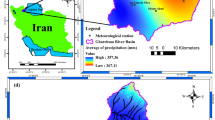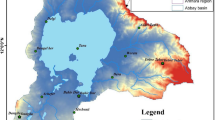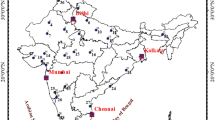Abstract
In this study, we proposed and tested a method based on system response curve (SRC) to extract the error information of areal mean rainfall. These extracted rainfall error are then used to update the rainfall time series data and propagated through the model to update the stream-flow forecast. The method is evaluated via synthetic and real-data cases. After our statistical analysis in different application scenarios, we found that the SRC method can effectively improve the accuracy of real-time flood forecasting when an optimal updating width is selected (the average relative error was reduced from 1.65% to 0.86%). In addition, we benchmark our results against a more conventional AR (Auto-Regression) streamflow-updating method. The average accuracy improvement of SRC method is 6.3% higher than that of AR method. More importantly, we found that the optimal updating width of SRC method is highly correlated with the average lead time of the basin, it has guiding significance for selecting the optimal updating width in practical application.










Similar content being viewed by others
References
Akaike H (1969) Fitting autoregressive models for prediction. Ann Inst Statal Math 21(1):243–247
Alemohammad SH, Entekhabi D, McLaughlin DB (2014) Evaluation of long-term SSM/I-based precipitation records over land. J Hydrometeorol 15(5):2012–2029
Alemohammad S, McColl K, Konings A, Entekhabi D, Stoffelen A (2015) Characterization of precipitation product errors across the US using multiplicative Triple Collocation. Hydrol Earth Syst Sci Discuss 12(2):2527–2559
Bao W, Zhang X, Yu Z, Qu S (2010) Real-time equivalent conversion correction on river stage forecasting with Manning’s formula. J Hydrol Eng 16(1):1–9
Bao W, Si W, Qu S (2013) Flow updating in real-time flood forecasting based on runoff correction by a dynamic system response curve. J Hydrol Eng 19(4):747–756
Bárdossy A, Singh S (2008) Robust estimation of hydrological model parameters. Hydrol Earth Syst Sci 12(6):1273–1283
Brisset E, Guiter F, Miramont C, Troussier T, Sabatier P, Poher Y, Cartier R, Arnaud F, Malet E, Anthony EJ (2017) The overlooked human influence in historic and prehistoric floods in the European Alps. Geology 45(4):347–350
Bulygina N, Gupta H (2009) Estimating the uncertain mathematical structure of a water balance model via Bayesian data assimilation. Water Resour Res 45(12):W00B13. https://doi.org/10.1029/2007WR006749
Cai Z, Fan J, Yao Q (2000) Function-coefficient regression models for nonlinear time series. J Am Stat Assoc 95(451):941–956
Chao Z, Hua-sheng H, Wei-min B, Luo-ping Z (2008) Robust recursive estimation of auto-regressive updating model parameters for real-time flood forecasting. J Hydrol 349(3–4):376–382
Chen CS, Jhong YD, Wu WZ, Chen ST (2019) Fuzzy time series for real-time flood forecasting. Stoch Env Res Risk Assess 33(3):645–656
Cheng KS, Lien YT, Wu YC, Su YF (2017) On the criteria of model performance evaluation for real-time flood forecasting. Stoch Env Res Risk Assess 31(5):1123–1146
Chua S, Bras RL (1982) Optimal estimators of mean areal precipitation in regions of orographic influence. J Hydrol 57(1):23–48
Cloke H, Pappenberger F (2009) Ensemble flood forecasting: a review. J Hydrol 375(3):613–626
Cunha LK, Smith JA, Krajewski WF, Baeck ML, Seo B-C (2015) NEXRAD NWS polarimetric precipitation product evaluation for IFloodS. J Hydrometeorol 16(4):1676–1699
Ebtehaj M, Moradkhani H, Gupta HV (2010) Improving robustness of hydrologic parameter estimation by the use of moving block bootstrap resampling. Water Resour Res 46(7):W07515. https://doi.org/10.1029/2009WR007981
Franchini M, Bernini A, Barbetta S, Moramarco T (2011) Forecasting discharges at the downstream end of a river reach through two simple Muskingum based procedures. J Hydrol 399(3):335–352
Gao L, Huang J, Chen X, Chen Y, Liu M (2018) Contributions of natural climate changes and human activities to the trend of extreme precipitation. Atmos Res 205:60–69
Gebregiorgis AS, Hossain F (2014) Estimation of satellite rainfall error variance using readily available geophysical features. IEEE Trans Geosci Remote Sens 52(1):288–304
Guo WJ, Wang CH, Ma TF, Zeng XM, Yang H (2016) A distributed Grid-Xinanjiang model with integration of subgrid variability of soil storage capacity. Water Sci Eng 9(2):97–105
Gupta HV, Clark MP, Vrugt JA, Abramowitz G, Ye M (2012) Towards a comprehensive assessment of model structural adequacy. Water Resour Res 48(8):W08301. https://doi.org/10.1029/2011WR011044
Hadi SJ, Tombul M (2018) Forecasting daily streamflow for basins with different physical characteristics through data-driven methods. Water Resour Manag 32(10):3405–3422
Hammond M, Han D (2008) Quantization analysis of weather radar data with synthetic rainfall. Stoch Env Res Risk Assess 22(3):367–377
Han T, Li Z, Liu K, Huang P (2015) Research on real-time correction method of flood forecasting in small mountain watershed. J Hohai Univ 43(3):208–214
Hostache R, Chini M, Giustarini L, Neal J, Kavetski D, Wood M, Corato G, Pelich RM, Matgen P (2018) Near-real-time assimilation of SAR-derived flood maps for improving flood forecasts. Water Resour Res 54(8):5516–5535
Kim D, Olivera F, Cho H (2013) Effect of the inter-annual variability of rainfall statistics on stochastically generated rainfall time series: part 1. Impact on peak and extreme rainfall values. Stoch Environ Res Risk Assess 27(7):1601–1610
Koutsoyiannis D (2000) A generalized mathematical framework for stochastic simulation and forecast of hydrologic time series. Water Resour Res 36(6):1519–1533
Kuczera G, Kavetski D, Franks S, Thyer M (2006) Towards a Bayesian total error analysis of conceptual rainfall-runoff models: characterising model error using storm-dependent parameters. J Hydrol 331(1):161–177
Larson LW, Peck EL (1974) Accuracy of precipitation measurements for hydrologic modeling. Water Resour Res 10(4):857–863
Li M, Shao Q, Renzullo L (2010) Estimation and spatial interpolation of rainfall intensity distribution from the effective rate of precipitation. Stoch Env Res Risk Assess 24(1):117–130
Liu K, Yao C, Li Z, Kan G, Bao H (2014) Comparison of real-time correction methods of hydrodynamic model. J Hohai Univ 42(2):124–129
Liu K, Yao C, Chen J, Li Z, Li Q, Sun L (2017) Comparison of three updating models for real time forecasting: a case study of flood forecasting at the middle reaches of the Huai river in East China. Stoch Env Res Risk Assess 31(6):1471–1484
Lohani AK, Kumar R, Singh RD (2012) Hydrological time series modeling: a comparison between adaptive neuro-fuzzy, neural network and autoregressive techniques. J Hydrol 442:23–35
Madsen H, Skotner C (2005) Adaptive state updating in real-time river flow forecasting-A combined filtering and error forecasting procedure. J Hydrol 308(1):302–312
Moradkhani H, DeChant CM, Sorooshian S (2012) Evolution of ensemble data assimilation for uncertainty quantification using the particle filter-Markov chain Monte Carlo method. Water Resour Res 48(12):W12520. https://doi.org/10.1029/2012WR012144
Park T, Lee T, Ahn S, Lee D (2016) Error influence of radar rainfall estimate on rainfall-runoff simulation. Stoch Env Res Risk Assess 30(1):283–292
Park T, Lee T, Ko D, Shin J, Lee D (2017) Assessing spatially dependent errors in radar rainfall estimates for rainfall-runoff simulation. Stoch Env Res Risk Assess 31(7):1823–1838
Pedretti D, Beckie RD (2015) Stochastic evaluation of simple pairing approaches to reconstruct incomplete rainfall time series. Stoch Env Res Risk Assess 30(7):1–14
Prat O, Nelson B (2014) Evaluation of precipitation estimates over CONUS derived from satellite, radar, and rain gauge datasets (2002–2012). Hydrol Earth Syst Sci Discuss 19(4):2037–2056
Qu S, Bao W (2003) Comprehensive correction of real-time flood forecasting. Adv Water Sci 14(2):167–171
Schaefli B, Gupta H (2007) Do Nash values have value? Hydrol Process 21(15):2075–2080. https://doi.org/10.1002/hyp.6825
Shi P, Yang T, Xu CY, Yong B, Shao Q, Li Z, Wang X, Zhou X, Li S (2017) How do the multiple large-scale climate oscillations trigger extreme precipitation? Glob Planet Change 157:48–58
Si W, Bao W, Gupta HV (2015) Updating real-time flood forecasts via the dynamic system response curve method. Water Resour Res 51(7):5128–5144. https://doi.org/10.1002/2015WR017234
Si W, Bao W, Qu S, Zhou M, Shi P, Yang X (2017) Modelling the effect of land use change on hydrological model parameters via linearized calibration method in the upstream of Huaihe river Basin. China Water S A 43(2):275–284
Si W, Bao W, Wang S, Cui Y, Niu Z, Yu H (2019a) A bivariable coupling model for river channel routing developed from the flow continuity equation and its application. Water S A 45(2):199–208
Si W, Gupta HV, Bao W, Jiang P, Wang W (2019b) Improved dynamic system response curve method for real-time flood forecast updating. Water Resour Res 55(9):7493–7519
Si-min Q, Wei-min B, Peng S, Chao Z (2003) Robust estimation of parameters for AR model error correction equation. J Hehai Univ 31(5):497–500
Song X, Kong F, Zhan C, Han J, Zhang X, Yu Y (2013) Parameter identification and global sensitivity analysis of Xin’anjiang model using meta-modeling approach. Water Sci Eng 6(1):1–17
Villarini G, Seo B-C, Serinaldi F, Krajewski WF (2014) Spatial and temporal modeling of radar rainfall uncertainties. Atmos Res 135:91–101
Wang G, Zhang J, Xu Y, Bao Z, Yang X (2017) Estimation of future water resources of Xiangjiang river Basin with VIC model under multiple climate scenarios. Water Sci Eng 10(2):87–96
Weerts AH, El Serafy GY (2006) Particle filtering and ensemble Kalman filtering for state updating with hydrological conceptual rainfall-runoff models. Water Resour Res 42(9):W12520. https://doi.org/10.1029/2005WR004093
Wenbo H, Zhijia L, Jingfeng W, Cheng Y, Ke Z, Yingchun H (2018) Multiple hydrological models comparison and an improved Bayesian model averaging approach for ensemble prediction over semi-humid regions. Stoch Env Res Risk Assess 33(1):217–238
Wong H, Ip W-c, Zhang R, Xia J (2007) Non-parametric time series models for hydrological forecasting. J Hydrol 332(3–4):337–347
Wu SJ, Chang CH, Hsu CT (2020) Real-time error correction of two-dimensional flood-inundation simulations during rainstorm events. Stoch Env Res Risk Assess 34(5):641–667
Yao C, Li Z, Yu Z, Zhang K (2012) A priori parameter estimates for a distributed, grid-based Xinanjiang model using geographically based information. J Hydrol 468:47–62
Yu Z, Yang T, Schwartz FW (2014) Water issues and prospects for hydrological science in China. Water Sci Eng 7(1):1–4
Zhang X, Liu P, Cheng L, Liu Z, Zhao Y (2018) A back-fitting algorithm to improve real-time flood forecasting. J Hydrol 562:140–150
Zhao RJ (1992) The Xinanjiang model applied in China. J Hydrol 135:371–381
Zhao RJ (1993) A non-linear system model for basin concentration. J Hydrol 142:477–482
Zhou M, Xia J, Lu J, Deng S, Lin F (2017) Morphological adjustments in a meandering reach of the middle Yangtze river caused by severe human activities. Geomorphology 285:325–332
Acknowledgements
This work was supported by the Fundamental Research Funds for Central Universities (B200201027), National Natural Science Foundation of China (51709077/51809174) and Open Research Fund of Yellow River Sediment Key Laboratory (201804). Data, material and code used in this study are available upon request from the corresponding author.
Author information
Authors and Affiliations
Corresponding author
Ethics declarations
Conflict of interest
The authors declare that they have no conflict of interest.
Additional information
Publisher's Note
Springer Nature remains neutral with regard to jurisdictional claims in published maps and institutional affiliations.
Supplementary information
Rights and permissions
About this article
Cite this article
Si, W., Zhong, H., Jiang, P. et al. A dynamic information extraction method for areal mean rainfall error and its application in basins of different scales for flood forecasting. Stoch Environ Res Risk Assess 35, 255–270 (2021). https://doi.org/10.1007/s00477-020-01957-z
Accepted:
Published:
Issue Date:
DOI: https://doi.org/10.1007/s00477-020-01957-z




